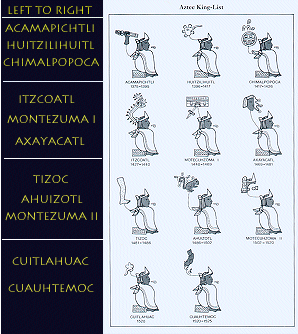
The idea of kingship in Aztec society cannot be understood in political and economic terms alone. The tlatoani was also the focus of religious activities by which the prosperity and continuity of the community were ensured. When a new tlataoni was initiated into office, he became the central protagonist of a ritual drama that engaged the whole nation.
The election of a new tlatoani at Tenochtitilan was not based on the family tree. As the old ruler neared the end of his life he would confirm his choice of a successor. In effect this would have already been prearranged. The candidate always came from a very restricted group of princes. Two pre-imperial tlatoani were sons of the rulers, but after Itzcoatl there was a succession of brothers, nephews, and grandsons belonging to an extended family oligarchy. The selection and election process was only the beginning of a rite of passage by which the prince would be transformed into the semi-deified, supreme source of authority in the Aztec State.
The rites of kingship at Tenochtitlan were organized in distinct episodes, featuring elaborate processions, speeches, prayers and performances carefully staged for dramatic effect. The Great Pyramid formed the central stage and point of reference. The royal rites of passage unfolded in a sequence of four phases.
1. Separation and retreat, 2. Investiture and coronation, 3. The coronation war and 4. Confirmation.
Separation and retreat
During this phase society was in a state of suspension following the death of the previous ruler. The ruler-elect withdrew from all usual social contact as a ritual detachment from his former status and functions. The separation began when he was formally stripped of his finery and all emblems of rank and authority. Wearing only a loincloth, he was led by the rulers of Tetzcoco and Tlacopan to the base of the Great Pyramid stairway. On the high platform he was dressed in a dark green cape with skull and crossbones designs. Once he was dressed in the garb of fasting and penitence, he burnt incense before Huitzilopochtli's shrine and then descended the stairway. Then he and his entourage entered the building known as the Tlacochcalco. Here began a four-day, four-night retreat, with fasting and penitential observances. During this time the prospective ruler contemplated the meaning and burdens of his office and the responsibilities of command.
Investiture and coronation
This second episode demonstrated the ruler's return to society and the assumption of his new social role. Now the ruler and his entourage moved onto one of the royal palaces. Within the palace he stood surrounded by nobles to be dressed in royal attire by the tlataoni of Tetzcoco. This dressing in the regalia of state signaled the taking of command as the first step in reconstructing Aztec society after the dissolution of the retreat. Once crowned, dressed, and seated, the ruler was carried to the Great Pyramid on an eagle and jaguar throne placed upon a litter. Once on top of the pyramid, in Huitzilopochtli's shrine, the new ruler was presented with a jaguar's claw for sacrificial bloodletting from the ears and legs.
Then they moved down the pyramid to a place that contained sculptured monuments. At these monuments, the ruler would offered drops of royal blood from his arms and legs and he also sacrificed quail. The final station in this ritual enclosure was the earth-temple known as Yopico. Here the connection between war and agriculture was vividly demonstrated. It was through sacrifice to the earth that the transfer of power to the new tlatoani was consecrated and made legal. Returning to the palace, the new ruler was seated for the ceremony of speeches, which marked the conclusion of this stage.
The coronation war
Before the tlatoani could be considered fully confirmed as the commander of the Aztec nation, he was required to prove his leadership in battle, to win tribute, and to capture prisoners for sacrifice in the final ceremony of confirmation. His return to the capital was the occasion of a grand triumph, and the booty obtained in the campaign went far to finance the lavish display laid on for his confirmation ceremony.
Confirmation
Now the final step in the rites of kingship began. Proclamations and invitations were sent to all allies and important rulers including those of enemy nations. In due time the presents began to arrive. Within the city, artisans and craftspeople made preparations. The feasts that ere to follow were offered by the tlatoani himself. In Aztec society the idea of kingship embraced two principal functions. The first was rooted in an ancient chthonic religion and its creation mythology, personified by the tlatoani as a magical rainmaker-king in the annual rites. He was responsible for scheduling and performing the sacrifice for agricultural renewal. The second notion was linked to the first conception. The ruler was an invincible warrior, embodying the image of Huitzilopochtli.

Kings List